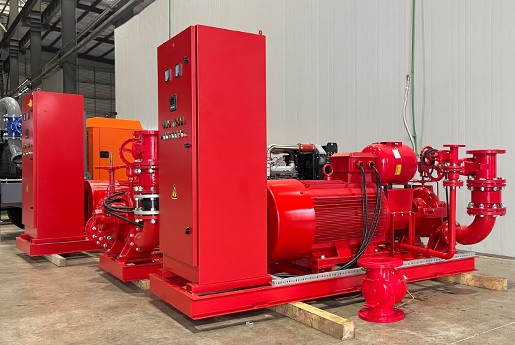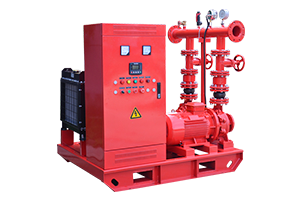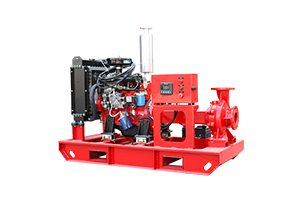-
 Nov 17, 2023How to self-test when a fire pump encounters a problem?Testing a fire pump is crucial to ensure it functions properly in the event of a fire emergency. Here are general steps you can take to self-test a fire pump:
Nov 17, 2023How to self-test when a fire pump encounters a problem?Testing a fire pump is crucial to ensure it functions properly in the event of a fire emergency. Here are general steps you can take to self-test a fire pump:
View details -
 Nov 16, 2023Causes and treatment methods of fire pump leakageFire pump leakage can occur for various reasons, and it's essential to identify the cause promptly and apply appropriate treatment methods to maintain the pump's reliability. Here are common causes and treatment methods for fire pump leakage:
Nov 16, 2023Causes and treatment methods of fire pump leakageFire pump leakage can occur for various reasons, and it's essential to identify the cause promptly and apply appropriate treatment methods to maintain the pump's reliability. Here are common causes and treatment methods for fire pump leakage:
View details -
 Nov 16, 2023Requirements for outdoor fire duct layoutDesigning an outdoor fire duct layout involves considering various factors to ensure the safety and effectiveness of the system. Here are some key requirements to keep in mind:
Nov 16, 2023Requirements for outdoor fire duct layoutDesigning an outdoor fire duct layout involves considering various factors to ensure the safety and effectiveness of the system. Here are some key requirements to keep in mind:
Compliance with Codes and Standards:
Ensure compliance with local building codes, fire codes, and relevant standards such as NFPA (National Fire Protection Association) standards, especially NFPA 96 for ventilation control and fire protection of commercial cooking operations.
Clearance from Combustibles:
Maintain specified clearances from combustible materials as per the applicable codes. This is crucial to prevent the risk of fire spreading to nearby structures.
Proper Sizing:
Size the outdoor fire duct appropriately to accommodate the exhaust volume and velocity. This should be based on the type of equipment producing the exhaust and the specific requirements of the ventilation system.
Material Selection:
Use materials that are suitable for outdoor environments and can withstand exposure to weather conditions. Stainless steel is a common choice for outdoor ductwork due to its durability and resistance to corrosion.
Weather Protection:
Design the duct layout to minimize exposure to adverse weather conditions, such as rain and snow, to prevent water ingress. Consider using rain caps or other protective measures as needed.
Protection from Physical Damage:
Take measures to protect the ductwork from physical damage, either intentional or accidental. This may involve installing barriers, bollards, or other protective devices.
Gravity Drainage:
Ensure that the duct layout allows for proper gravity drainage of any condensate or moisture that may accumulate within the system.
Support and Hangers:
Provide adequate support and hangers for the outdoor ductwork to ensure stability and prevent sagging or misalignment. Consider the effects of wind loads on the ductwork.
Access for Inspection and Maintenance:
Design the layout to allow for easy access for inspection and maintenance activities. This is crucial for identifying and addressing any issues promptly.
Exhaust Discharge Location:
Determine a suitable location for the discharge of exhaust air to minimize its impact on neighboring properties and comply with local regulations.
Fire Dampers and Smoke Control:
Integrate fire dampers as required by codes to prevent the spread of fire through the ductwork. Consider smoke control measures if applicable.
Coordination with Other Systems:
Coordinate the outdoor fire duct layout with other building systems to avoid conflicts and ensure a comprehensive and integrated approach to fire safety.
Professional Engineering Design:
Engage a qualified fire protection engineer or HVAC (heating, ventilation, and air conditioning) professional to design the outdoor fire duct layout. Their expertise is essential for ensuring compliance with codes and optimizing system performance.
Always consult with local authorities having jurisdiction and professionals with expertise in fire protection engineering to ensure that the outdoor fire duct layout meets all necessary requirements and standards for your specific location and application.View details -
 Nov 15, 2023What should I do if the fire pump pressure is insufficient?If you encounter insufficient pressure from a fire pump, it's crucial to address the issue promptly to ensure the effectiveness of your fire protection system. Here are steps you can take:
Nov 15, 2023What should I do if the fire pump pressure is insufficient?If you encounter insufficient pressure from a fire pump, it's crucial to address the issue promptly to ensure the effectiveness of your fire protection system. Here are steps you can take:
Check for Obvious Issues:
Inspect the pump and its components for any visible issues such as leaks, damaged pipes, or blockages.
Ensure that the suction and discharge valves are fully open and unobstructed.
Verify Water Source:
Ensure that an adequate water supply is available to the pump. Check that the water source, such as a reservoir or a municipal water supply, is not compromised.
Inspect Intake Strainer:
The intake strainer may become clogged with debris, affecting water flow. Inspect and clean the strainer if necessary.
Check for Air in the System:
Air pockets in the pump or piping can reduce pressure. Bleed air from the system by opening air release valves or using other appropriate methods.
Verify Pump Rotation:
For centrifugal pumps, check the rotation direction. If the pump is rotating in the wrong direction, it may not generate sufficient pressure. Correct the rotation if needed.
Monitor Power Supply:
Ensure that the pump is receiving an adequate power supply. If it's an electric pump, check for electrical issues. For diesel pumps, ensure the engine is functioning properly.
Inspect Pump Settings:
Check the pump's pressure settings to ensure they are configured correctly. Adjust the settings if necessary, but be sure to adhere to safety and performance guidelines.
Review System Design:
If the fire protection system has been modified or expanded, ensure that the pump's capacity matches the system's requirements. Consult with a qualified professional if adjustments are needed.
Check for Pump Wear:
Over time, pumps can experience wear and tear. Inspect pump components for signs of wear, and replace or repair any damaged parts.
Consult with Professionals:
If you are unable to identify or rectify the issue, it's essential to consult with qualified professionals, such as a fire protection engineer or a certified technician. They can perform a more in-depth analysis and recommend appropriate solutions.
Regular Maintenance:
Implement a regular maintenance schedule for the fire pump. Preventive maintenance helps identify potential issues before they cause a failure.
Remember, the fire pump is a critical component of the fire protection system, and any issues with its performance should be addressed promptly to ensure the safety of occupants and property. Always follow manufacturer recommendations, industry standards, and local codes when troubleshooting or maintaining fire pump systems.
View details -
.jpg) Nov 15, 2023Features of fire pump main pump and backup pumpFire pumps are a crucial component of fire protection systems, ensuring an adequate water supply to combat fires. There are generally two types of fire pumps: the main pump and the backup pump. Here are some features and considerations for both:
Nov 15, 2023Features of fire pump main pump and backup pumpFire pumps are a crucial component of fire protection systems, ensuring an adequate water supply to combat fires. There are generally two types of fire pumps: the main pump and the backup pump. Here are some features and considerations for both:
View details -
 Nov 14, 2023Fire pump self-checking functionFire pumps are critical components of fire protection systems, and their proper functioning is crucial for ensuring the availability of water during a fire emergency. Self-checking functions in fire pumps are designed to automatically test and monitor various aspects of the pump system, ensuring that it is ready to operate when needed. Here are some common self-checking functions found in fire pumps:
Nov 14, 2023Fire pump self-checking functionFire pumps are critical components of fire protection systems, and their proper functioning is crucial for ensuring the availability of water during a fire emergency. Self-checking functions in fire pumps are designed to automatically test and monitor various aspects of the pump system, ensuring that it is ready to operate when needed. Here are some common self-checking functions found in fire pumps:
View details






